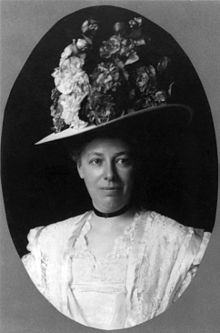陇山陇西郡
宁静纯我心 感得事物人 写朴实清新. 闲书闲话养闲心,闲笔闲写记闲人;人生无虞懂珍惜,以沫相濡字字真。The book you're referring to is "The Bully Pulpit: Theodore Roosevelt, William Howard Taft, and the Golden Age of Journalism" by Doris Kearns Goodwin. This Pulitzer Prize-winning biography explores the relationship between Theodore Roosevelt, William Howard Taft, and their influence on journalism during the early 20th century. While it isn't exclusively about Helen "Nellie" Taft, the book covers her role and influence during Taft's presidency? (Wikipedia).
Doris Kearns Goodwin is a highly regarded historian and author, known for her detailed and insightful biographical works.
Both "second-hand book" and "used book" are correct and commonly used terms. They refer to a book that has been owned or read by someone else before being sold again. "Second-hand book" is more common in British English, while "used book" is more frequently used in American English.
Helen Louise "Nellie" Taft (née Herron; June 2, 1861 – May 22, 1943) was the First Lady of the United States from 1909 to 1913 as the wife of President William Howard Taft. Born to a politically well-connected Ohio family, she took an early interest in political life, deciding at the age of 17 that she wished to become first lady. Herron married Taft in 1886, and she guided him throughout his political career, encouraging him to take actions that would bring him closer to the presidency. Accompanying her husband to the Philippines in 1900, she became a prominent socialite in Manila, contributing to US-Philippines relations. After her husband was appointed Secretary of War, she played a significant role in convincing him to run for president in the 1908 presidential election and making the necessary connections to ensure his success.
As first lady, Taft was closely involved in the political aspects of the presidency, regularly sitting in on meetings and serving as her husband's closest advisor. She held a strong influence over the president's decisions, expressing her concerns when she disagreed with him and providing her input on presidential appointments. She also carried out a reorganization of the White House staff and decor. Inspired by her experience in the Philippines, she converted the White House lawn and the West Potomac Park into social hubs with regular live shows and events. Her decision to plant cherry trees in the park proved to be a success, creating a popular tourist attraction. Taft's influence as first lady was cut short by a stroke two months into her tenure, permanently limiting her mobility and leaving her absent for a year while she partially recovered.
Though President Taft was relieved that his term had ended, Helen Taft was upset by his defeat for reelection. She remained active after leaving the White House, supporting the Red Cross during World War I and participating in activities for the Colonial Dames of America. She was widowed in 1930, and she was buried beside her husband in Arlington National Cemetery after her death in 1943.
| Helen Herron Taft | |
|---|---|
 Taft in 1908 | |
| First Lady of the United States | |
| In role March 4, 1909 – March 4, 1913 | |
| President | William Howard Taft |
| Preceded by | Edith Roosevelt |
| Succeeded by | Ellen Wilson |
| Personal details | |
| Born | Helen Louise Herron June 2, 1861 Cincinnati, Ohio, U.S. |
| Died | May 22, 1943 (aged 81) Washington, D.C., U.S. |
| Resting place | Arlington National Cemetery |
| Spouse | |
| Children | |
| Education | University of Cincinnati |
| Signature |  |
The correct terms are "hardcover" and "paperback."
- Hardcover (or hardback): A book bound with rigid protective covers, usually made of cardboard covered with cloth, paper, or leather.
- Paperback: A book with a flexible paper cover, often less expensive and more portable than a hardcover book.
These terms are standard in the publishing industry
This Day in History: William Taft's ambitious wife
Nellie Taft: The Unconventional First Lady of the Ragtime Era Hardcover – Deckle Edge, April 12, 2005
On the morning of William Howard Taft's inauguration, Nellie Taft publicly expressed that theirs would be a joint administration by shattering precedent and demanding that she ride alongside her husband down Pennsylvania Avenue, a seat previously held for the outgoing President. In addition to her passion for entertaining, this progressive First Lady was an advocate for higher education and partial suffrage for women, initiated legislation to improve working conditions for federal employees, and created Washington's famous grove of blossoming cherry trees. She smoked, drank, and gambled without regard to societal judgment. During Taft's time as the governor general of the Philippines, she broke racial and class boundaries. Nellie Taft's fate was ultimately bound to larger events, including the Titanic sinking and Teddy Roosevelt's creation of the Bull Moose Party.
Drawn from previously unpublished diaries, a lifetime of love letters between Will and Nellie, and detailed family correspondence and recollections, Anthony develops a riveting portrait of Nellie Taft as one of the strongest links in the series of women -- from Abigail Adams to Hillary Rodham Clinton -- often critically declared "co-Presidents."
Editorial Reviews
From Publishers Weekly
Copyright © Reed Business Information, a division of Reed Elsevier Inc. All rights reserved.
From Booklist
Copyright © American Library Association. All rights reserved
Product details
- Publisher : William Morrow; First Edition (April 12, 2005)
- Language : English
- Hardcover : 544 pages
- ISBN-10 : 0060513829
- ISBN-13 : 978-0060513825
- Item Weight : 1.9 pounds
- Dimensions : 6.5 x 1.25 x 9 inches
- Best Sellers Rank: #2,031,692 in Books (See Top 100 in Books)
- #5,971 in Women in History
- #18,034 in World War II History (Books)
- #20,439 in Women's Biographies
- Customer Reviews:




